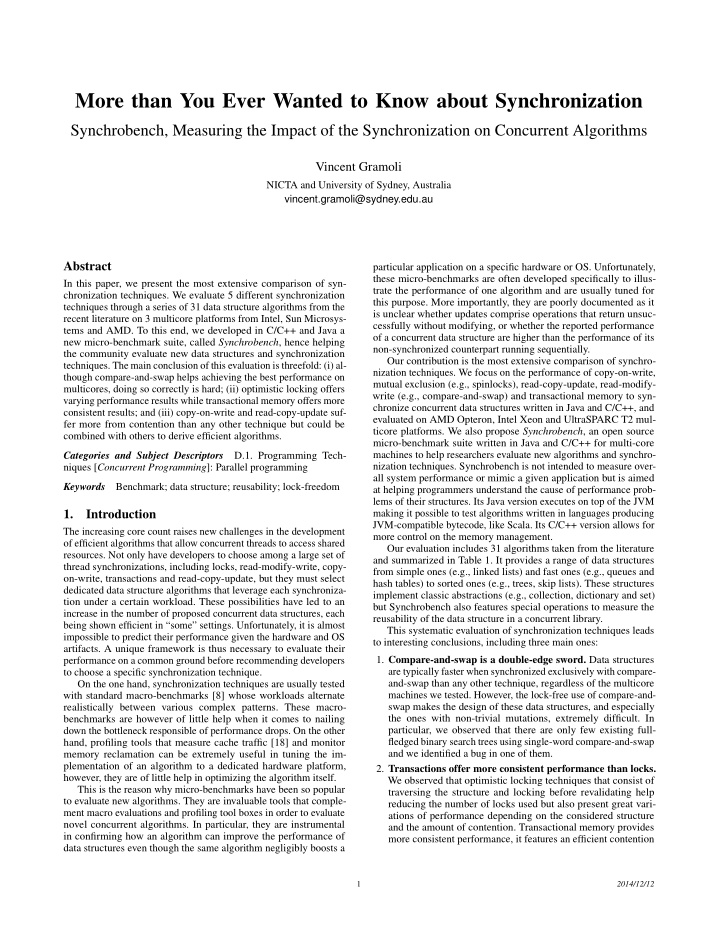



More than You Ever Wanted to Know about Synchronization Synchrobench, Measuring the Impact of the Synchronization on Concurrent Algorithms Vincent Gramoli NICTA and University of Sydney, Australia vincent.gramoli@sydney.edu.au Abstract particular application on a specific hardware or OS. Unfortunately, these micro-benchmarks are often developed specifically to illus- In this paper, we present the most extensive comparison of syn- trate the performance of one algorithm and are usually tuned for chronization techniques. We evaluate 5 different synchronization this purpose. More importantly, they are poorly documented as it techniques through a series of 31 data structure algorithms from the is unclear whether updates comprise operations that return unsuc- recent literature on 3 multicore platforms from Intel, Sun Microsys- cessfully without modifying, or whether the reported performance tems and AMD. To this end, we developed in C/C++ and Java a of a concurrent data structure are higher than the performance of its new micro-benchmark suite, called Synchrobench , hence helping non-synchronized counterpart running sequentially. the community evaluate new data structures and synchronization Our contribution is the most extensive comparison of synchro- techniques. The main conclusion of this evaluation is threefold: (i) al- nization techniques. We focus on the performance of copy-on-write, though compare-and-swap helps achieving the best performance on mutual exclusion (e.g., spinlocks), read-copy-update, read-modify- multicores, doing so correctly is hard; (ii) optimistic locking offers write (e.g., compare-and-swap) and transactional memory to syn- varying performance results while transactional memory offers more chronize concurrent data structures written in Java and C/C++, and consistent results; and (iii) copy-on-write and read-copy-update suf- evaluated on AMD Opteron, Intel Xeon and UltraSPARC T2 mul- fer more from contention than any other technique but could be ticore platforms. We also propose Synchrobench , an open source combined with others to derive efficient algorithms. micro-benchmark suite written in Java and C/C++ for multi-core Categories and Subject Descriptors D.1. Programming Tech- machines to help researchers evaluate new algorithms and synchro- niques [ Concurrent Programming ]: Parallel programming nization techniques. Synchrobench is not intended to measure over- all system performance or mimic a given application but is aimed Keywords Benchmark; data structure; reusability; lock-freedom at helping programmers understand the cause of performance prob- lems of their structures. Its Java version executes on top of the JVM making it possible to test algorithms written in languages producing 1. Introduction JVM-compatible bytecode, like Scala. Its C/C++ version allows for The increasing core count raises new challenges in the development more control on the memory management. of efficient algorithms that allow concurrent threads to access shared Our evaluation includes 31 algorithms taken from the literature resources. Not only have developers to choose among a large set of and summarized in Table 1. It provides a range of data structures thread synchronizations, including locks, read-modify-write, copy- from simple ones (e.g., linked lists) and fast ones (e.g., queues and on-write, transactions and read-copy-update, but they must select hash tables) to sorted ones (e.g., trees, skip lists). These structures dedicated data structure algorithms that leverage each synchroniza- implement classic abstractions (e.g., collection, dictionary and set) tion under a certain workload. These possibilities have led to an but Synchrobench also features special operations to measure the increase in the number of proposed concurrent data structures, each reusability of the data structure in a concurrent library. being shown efficient in “some” settings. Unfortunately, it is almost This systematic evaluation of synchronization techniques leads impossible to predict their performance given the hardware and OS to interesting conclusions, including three main ones: artifacts. A unique framework is thus necessary to evaluate their performance on a common ground before recommending developers 1. Compare-and-swap is a double-edge sword. Data structures to choose a specific synchronization technique. are typically faster when synchronized exclusively with compare- On the one hand, synchronization techniques are usually tested and-swap than any other technique, regardless of the multicore with standard macro-benchmarks [ 8 ] whose workloads alternate machines we tested. However, the lock-free use of compare-and- realistically between various complex patterns. These macro- swap makes the design of these data structures, and especially benchmarks are however of little help when it comes to nailing the ones with non-trivial mutations, extremely difficult. In down the bottleneck responsible of performance drops. On the other particular, we observed that there are only few existing full- hand, profiling tools that measure cache traffic [ 18 ] and monitor fledged binary search trees using single-word compare-and-swap memory reclamation can be extremely useful in tuning the im- and we identified a bug in one of them. plementation of an algorithm to a dedicated hardware platform, 2. Transactions offer more consistent performance than locks. however, they are of little help in optimizing the algorithm itself. We observed that optimistic locking techniques that consist of This is the reason why micro-benchmarks have been so popular traversing the structure and locking before revalidating help to evaluate new algorithms. They are invaluable tools that comple- reducing the number of locks used but also present great vari- ment macro evaluations and profiling tool boxes in order to evaluate ations of performance depending on the considered structure novel concurrent algorithms. In particular, they are instrumental and the amount of contention. Transactional memory provides in confirming how an algorithm can improve the performance of more consistent performance, it features an efficient contention data structures even though the same algorithm negligibly boosts a 1 2014/12/12
Recommend
More recommend